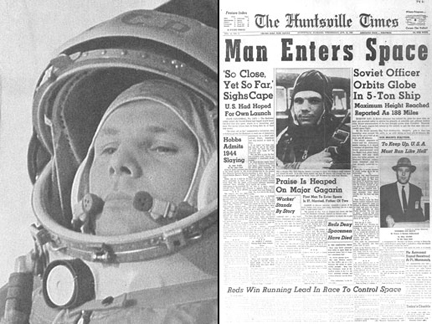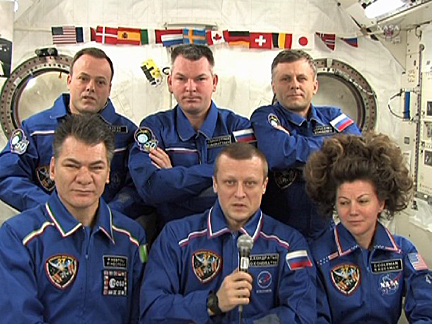Station crew, space officials mark Gagarin anniversary
04/12/2011 12:33 PM Filed in: Space News | International Space Station
By WILLIAM HARWOOD
CBS News
The crew of the International Space Station joined Russian leaders and space officials, their NASA counterparts and international partners around the world Tuesday to celebrate the 50th anniversary of Yuri Gagarin's launch on April 12, 1961, to become the first human in space.
"In the 20th century, it has become the most extraordinary event, the most significant event not only in Russia but the whole world and we're very proud of the fact that the first cosmonaut went into space on April 12, 1961, and he was our compatriot," Anatoly Perminov, director general of the Russian space agency Roskosmos, said Monday at the Cosmonautics Memorial Museum in Moscow.
"It's not possible today to imagine our modern life without acknowledging the results of space exploration," he said. "Today spaceflight has ceased being something extraordinary or unusual or something out of science fiction. Even such a notion as space tourism has appeared. I'm very happy to announce that upon the decision of the special session of the United Nations, April the 12th has been declared a special holiday."
Yuri Alekseyevich Gagarin, a 27-year-old lieutenant in the Soviet air force, blasted off aboard the Vostok 1 spacecraft at 6:07 a.m. GMT on April 12. He completed one orbit around the world before re-entry, ejecting from his descent capsule and making a successful landing by parachute.
The one-hour 48-minute flight was an international sensation, giving the Soviet Union a widely perceived lead in the infant manned space race. Alan Shepard would complete a brief sub-orbital flight aboard a NASA Mercury-Redstone rocket on May 5, 1961, but Gagarin's orbital flight was viewed by many as a daunting achievement of Soviet technology, spurring the development of increasingly sophisticated spacecraft.
But Gagarin never flew in space again. A Hero of the Soviet Union, he was killed in a routine training flight on March 27, 1968.
"Because of an individual act of courage backed by a nation of strength, we have gone from competition in the spaceflight program to cooperation to inspiration," said Steve MacLean, president of the Canadian Space Agency and a veteran shuttle astronaut. "The inspiration of Yuri Gagarin's spaceflight changes the way we see space, and especially for the inspiration of our children. There are generations of children who have never known anything but space travel."
MacLean joined senior Russian space officials, NASA managers and representatives of the International Space Station project, along with cosmonauts and astronauts, at the Cosmonautics Museum to mark the golden anniversary of the first manned space flight. Gagarin's daughter, Elena, said "it's wonderful that today we have cosmonauts and astronauts gathered who come from many countries and who participate in our space exploration."
"The fact that everyone is here speaks to the fact that modern science is not possible without the efforts of all the countries, all continents. it wouldn't be possible without the good will of various countries that join their efforts together in order to move our humanity forward. i would like to congratulate everyone."
The 50th anniversary of Gagarin's flight coincides with the 30th anniversary of the first shuttle launch on April 12, 1981. Only two more shuttle launches remain -- one by Endeavour on April 29 and a final voyage by Atlantis on June 28. NASA's third shuttle, Discovery, completed its final mission last month. It's in the process of being decommissioned before work to convert the ship for museum display.
At the Kennedy Space Center in Florida Tuesday, NASA Administrator Charles Bolden was expected to formally announce where each shuttle will end up, naming the winners in a national competition among leading museums vying to host one of the winged orbiters.
NASA is retiring its shuttle fleet in favor of commercial rockets and capsules that do not yet exist. In a reversal of fortune that would have been unthinkable a few short years ago, U.S. astronauts are now forced to buy seats aboard Russian Soyuz spacecraft to reach the International Space Station until new U.S. spacecraft can be developed and tested over the next several years.
In a symbolic sense at least, manned spaceflight has come full circle. Racing to achieve supremacy after Gagarin's trail-blazing mission, NASA successfully sent astronauts to the moon and went on to launch Skylab and then the space shuttle, the most sophisticated and capable manned spacecraft ever built. NASA later joined forces with the Russians, the European Space Agency, Japan and Canada to build the International Space Station.
But now, 50 years after Gagarin's flight, NASA stands at a crossroads and the future direction of the nation's manned space program is not yet clear.
In a crew interview from orbit, space station flight engineer Ronald Garan said uncertainty about the details of NASA's future path in space should not be mistaken for an abandonment of the high frontier.
"Fifty years ago when that first step into space was taken, it was a competition, it was basically an antagonistic competition between two nations," Garan told CBS News. "But what came of that space program, even at the height of the Cold War, somehow these two nations that were not always very friendly to each other found a way to cooperate. ... I think that's the legacy the space program brings, it brings people together. I really believe the world is a safer place than it would be otherwise if those first steps weren't taken into space."
As for the shuttle's retirement and NASA's reliance on the Russians for access to space until new U.S. rockets can be built, Garan said "this is a necessary step that we had to take so we could go onto the next step that we're going to take in exploration, the heavy lift boosters and the spacecraft that will take us out of low-earth orbit."
"That's really what our goal is, to get out of the business of low-Earth orbit, turn that over to commercial enterprises and to get on to what NASA and the other government agencies are really designed for, and that's exploration, pushing that envelope and going farther and farther."
CBS News
The crew of the International Space Station joined Russian leaders and space officials, their NASA counterparts and international partners around the world Tuesday to celebrate the 50th anniversary of Yuri Gagarin's launch on April 12, 1961, to become the first human in space.
 |
| Yuri Gagarin became the first man in space on April 12, 1961. (Photo: NASA) |
"It's not possible today to imagine our modern life without acknowledging the results of space exploration," he said. "Today spaceflight has ceased being something extraordinary or unusual or something out of science fiction. Even such a notion as space tourism has appeared. I'm very happy to announce that upon the decision of the special session of the United Nations, April the 12th has been declared a special holiday."
Yuri Alekseyevich Gagarin, a 27-year-old lieutenant in the Soviet air force, blasted off aboard the Vostok 1 spacecraft at 6:07 a.m. GMT on April 12. He completed one orbit around the world before re-entry, ejecting from his descent capsule and making a successful landing by parachute.
The one-hour 48-minute flight was an international sensation, giving the Soviet Union a widely perceived lead in the infant manned space race. Alan Shepard would complete a brief sub-orbital flight aboard a NASA Mercury-Redstone rocket on May 5, 1961, but Gagarin's orbital flight was viewed by many as a daunting achievement of Soviet technology, spurring the development of increasingly sophisticated spacecraft.
But Gagarin never flew in space again. A Hero of the Soviet Union, he was killed in a routine training flight on March 27, 1968.
"Because of an individual act of courage backed by a nation of strength, we have gone from competition in the spaceflight program to cooperation to inspiration," said Steve MacLean, president of the Canadian Space Agency and a veteran shuttle astronaut. "The inspiration of Yuri Gagarin's spaceflight changes the way we see space, and especially for the inspiration of our children. There are generations of children who have never known anything but space travel."
MacLean joined senior Russian space officials, NASA managers and representatives of the International Space Station project, along with cosmonauts and astronauts, at the Cosmonautics Museum to mark the golden anniversary of the first manned space flight. Gagarin's daughter, Elena, said "it's wonderful that today we have cosmonauts and astronauts gathered who come from many countries and who participate in our space exploration."
"The fact that everyone is here speaks to the fact that modern science is not possible without the efforts of all the countries, all continents. it wouldn't be possible without the good will of various countries that join their efforts together in order to move our humanity forward. i would like to congratulate everyone."
 |
| The crew of the International Space Station reflects on the golden anniversary of Yuri Gagarin's 1961 space flight. Front row, left to right: Paolo Nespoli, Dmitry Kondratyev, Catherine Coleman. Back row, left to right: Ronald Garan, Alexander Samokutyaev, Andrey Borisenko. (Photo: NASA TV) |
At the Kennedy Space Center in Florida Tuesday, NASA Administrator Charles Bolden was expected to formally announce where each shuttle will end up, naming the winners in a national competition among leading museums vying to host one of the winged orbiters.
NASA is retiring its shuttle fleet in favor of commercial rockets and capsules that do not yet exist. In a reversal of fortune that would have been unthinkable a few short years ago, U.S. astronauts are now forced to buy seats aboard Russian Soyuz spacecraft to reach the International Space Station until new U.S. spacecraft can be developed and tested over the next several years.
In a symbolic sense at least, manned spaceflight has come full circle. Racing to achieve supremacy after Gagarin's trail-blazing mission, NASA successfully sent astronauts to the moon and went on to launch Skylab and then the space shuttle, the most sophisticated and capable manned spacecraft ever built. NASA later joined forces with the Russians, the European Space Agency, Japan and Canada to build the International Space Station.
But now, 50 years after Gagarin's flight, NASA stands at a crossroads and the future direction of the nation's manned space program is not yet clear.
In a crew interview from orbit, space station flight engineer Ronald Garan said uncertainty about the details of NASA's future path in space should not be mistaken for an abandonment of the high frontier.
"Fifty years ago when that first step into space was taken, it was a competition, it was basically an antagonistic competition between two nations," Garan told CBS News. "But what came of that space program, even at the height of the Cold War, somehow these two nations that were not always very friendly to each other found a way to cooperate. ... I think that's the legacy the space program brings, it brings people together. I really believe the world is a safer place than it would be otherwise if those first steps weren't taken into space."
As for the shuttle's retirement and NASA's reliance on the Russians for access to space until new U.S. rockets can be built, Garan said "this is a necessary step that we had to take so we could go onto the next step that we're going to take in exploration, the heavy lift boosters and the spacecraft that will take us out of low-earth orbit."
"That's really what our goal is, to get out of the business of low-Earth orbit, turn that over to commercial enterprises and to get on to what NASA and the other government agencies are really designed for, and that's exploration, pushing that envelope and going farther and farther."